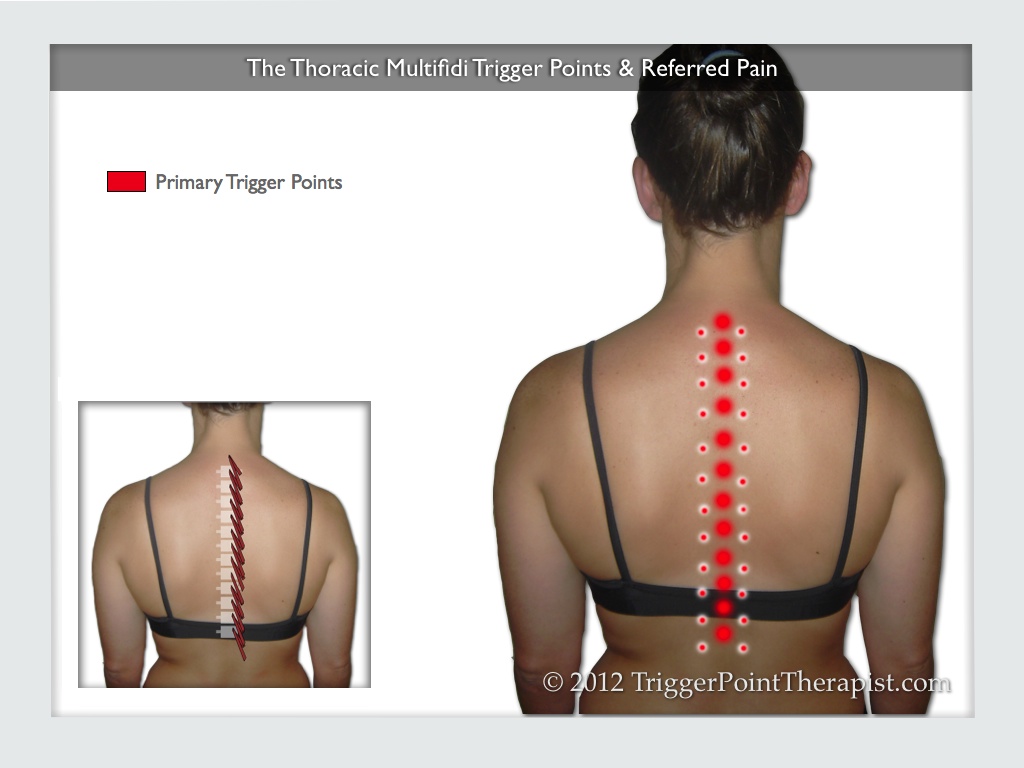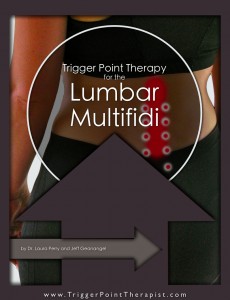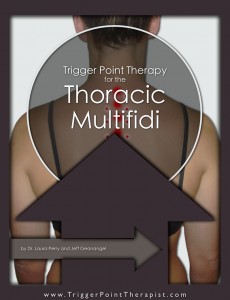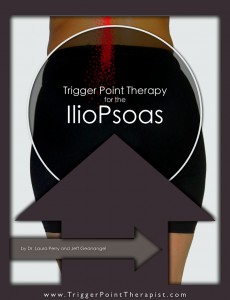The day that I learned about the multifidi trigger points was a revelation for me. As a chiropractor, I had battled the transitory effectiveness of spinal manipulation for years. My patients would complain that the pain relief provided by my chiropractic treatment only lasted for about a half an hour.
In frustration, I asked other chiropractors if they had the same experience and they reported the same situation. Of course, most chiropractors use this treatment shortcoming as an excuse for over-scheduling their patients. Seeing patients 3-5 times a week may be good for their pocket book, but there is absolutely no clinical evidence that it’s an effective treatment protocol.
I wanted to know what was causing my patient’s articular dysfunctions to return so quickly after my treatment. What I discovered is that trigger points in some of the small intrinsic muscles of the spine were not only causing the articular dysfunctions, but they also produced a “boney” type of spine pain themselves.
Releasing the trigger points in these muscles, called the multifidi muscles, not only supercharged my chiropractic treatments, but often eliminated the need for any type of spinal manipulation in most cases.
After treating many, many cases of spinal pain over the years, I have no doubt that locating and releasing the multifidi trigger points are the key to success. Just don’t try to tell a chiropractor that!
The Multifidus Muscles (a.k.a. the Multifidi)
Location: The multifidi muscle group is a chain of many small muscles that lie deep along each side of the lumbar and thoracic spine. Each muscle in this group connects a spinal vertebrae to the vertebrae 2 to 4 segments below it. As these muscles lie underneath several other layers of paraspinal muscle groups they are referred to as the deep paraspinal muscles.
Function: The multifidi function to control the positioning of spinal vertebrae relative to each other and to the sacrum. They also help to stabilize the spinal column during gross movements of the trunk.
Muscle Attachments: The multifidi muscles originate at the base of a vertebra’s spinous process and run diagonally downwards and laterally to attach to the transverse process of a vertebrae two, three, or four spinal segments below it. The lower lumbar multifidi extend downward to attach to sacral segments S1, S2, and S3 (and sometimes to S4).
Muscle Actions: Coordinated contraction of the multifidi group adjusts the positioning of the vertebrae facet joints to allow the larger prime movers of the spine and trunk to efficiently rotate and extend the spinal column.
Biomechanical Considerations: Tension in the multifidus muscles, and in the other deep paraspinal muscles, can produce mechanical stress on the joints that connect one vertebrae to another (the spinal facet joints). Over time, this stress will cause dysfunction in the facet joint and greatly reduce its mobility.
In the thoracic spine, facet joint dysfunction is easy to spot as it tends to cause a depression in the curve of the spine that spans several segments. Light palpation of the spine will easily detect the depressed area which is frequently also tender to the touch.
Facet joint dysfunction in the lumbar spine is not as visually (or tactically) apparent and traditionally requires a specialized diagnostic method called motion palpation to detect its presence.
The Multifidus Trigger Points
As shown in the diagrams below, the multifidi trigger points lie along each side of the spine and sacrum, within the paravertebral canals.
Multifidus Pain
The diagrams above also show the referred pain associated with the multifidi trigger points. Pain and tenderness is referred locally to the spinous process of the adjacent vertebrae and/or the vertebrae above it. Lumbar multifidi trigger points may also refer pain to the lateral abdomen region.
What Causes Multifidus Trigger Points?
The following events or activities may activate or reactivate the multifidi trigger points:
- Automobile accident (rapid deceleration)
- Unaddressed trigger point activity in the larger muscle groups that move the spine (i.e. quadratus lumborum, lumbar paraspinals, abdominal obliques etc)
- Articular dysfunction in the spine (facet syndrome)
- Distorted lumbar lordosis, thoracic kyphosis, or scoliosis
(For more information on the various causes of trigger points, please see Comprehending the Cause of Trigger Points.)
Multifidus Symptoms & Disorders
Clients with active multifidi trigger points will present with any or all of the following symptoms or clinical findings:
- Deep, persistent ache on the spine that is usually on one side only but will become bilateral over time. Pain doesn’t feel muscular in nature, rather it feels like “bone pain”.
- Spinous processes of the vertebrae become tender to the touch.
- Occasionally, pain may extend into the lateral abdomen.
- Noticeable stiffness develops in the spine.
- Changing positions doesn’t help to ameliorate pain.
- The muscles along one side of the spine may bulge out slightly.
- Articular dysfunctions (facet syndrome) in the lumbar spine that don’t respond to chiropractic or osteopathic manipulation.
Spinal Fixations and Multifidus Trigger Points
Multifidi trigger points perpetuate spinal articular dysfunctions. In fact, unaddressed multifidi trigger points are the primary reason that chiropractic and osteopathic spinal manipulations have such short-term success in treating spine pain conditions. Within twenty minutes after a spinal manipulation the tense multifidi muscles have restored the articular dysfunction in the facet joints that they created in the first place. Releasing the multifidi trigger points will not only also release the associated articular dysfunctions, but will provide longer lasting relief than spinal manipulation alone.
Treatment of Multifidus Trigger Points
For more information and step-by-step instructions for locating and releasing the multifidi trigger points in the lumbar and thoracic spine regions, you can purchase the Trigger Point Therapy for the Lumbar Multifidi and Trigger Point Therapy for the Thoracic Multifidi Video Downloads.
This content is also available as iPad Booklets in the iBookstore; Trigger Point Therapy for the Lumbar Multifidi Booklet and Trigger Point Therapy for the Thoracic Multifidi Booklet.
Click on the images below to view excerpts from these videos on YouTube:
YouTube Links: Lumbar Multifidus Trigger Points and Thoracic Multifidus Trigger Points.
Related Articles:
- Iliopsoas Trigger Points: Hidden Pranksters of Low Back Pain
- Trigger Point Therapy for Low Back Pain; Understanding the Complaint Within the Complaint
Related Instructional Videos:








